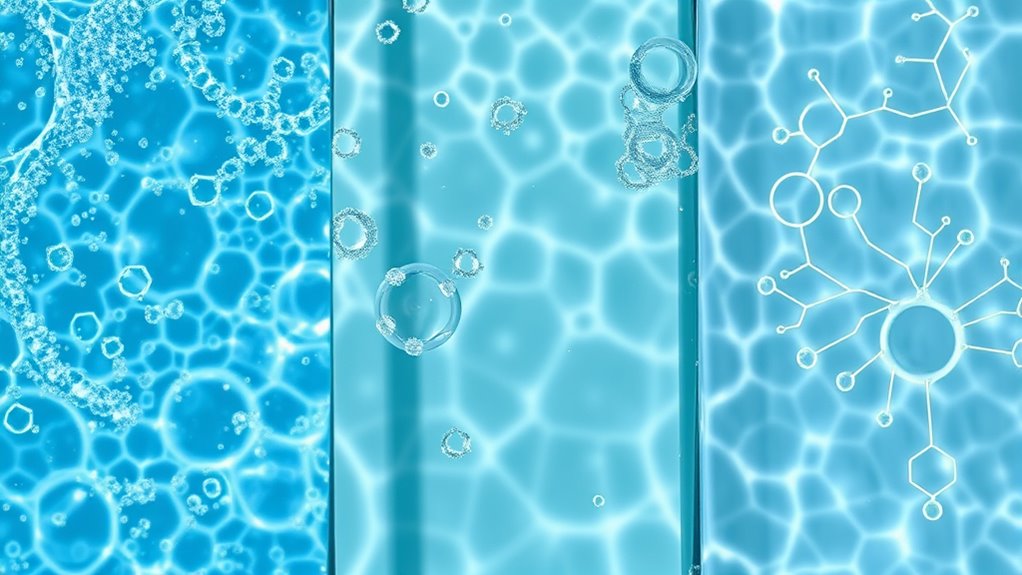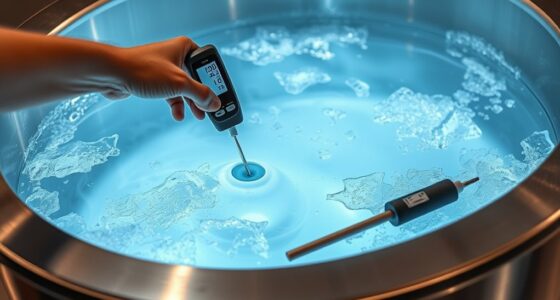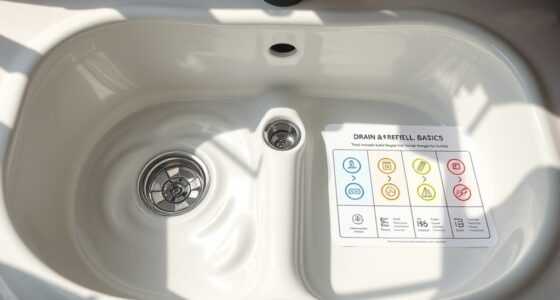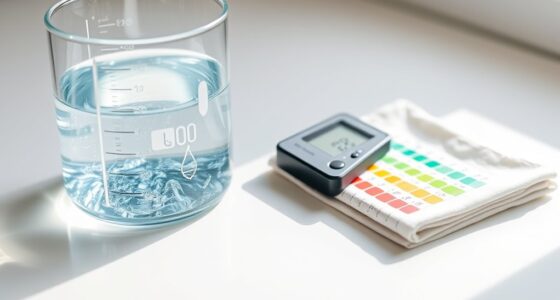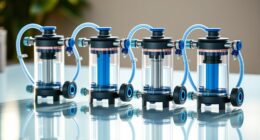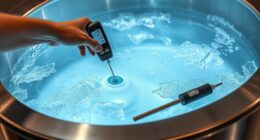When choosing a safe sanitizer, consider your needs: chlorine works quickly and is affordable but can produce harmful byproducts, making it less ideal for long-term use. Bromine stays stable at higher temperatures, great for hot water systems, but may cause allergic reactions. Enzymes are gentle and eco-friendly, perfect for minimal chemical exposure, but they might need frequent application. To find the best fit for your environment, explore the options further and weigh their safety and effectiveness.
Key Takeaways
- Chlorine is cost-effective and quickly kills bacteria but can produce harmful byproducts with organic matter.
- Bromine is stable at high temperatures, making it suitable for hot water systems like spas, but may cause allergic reactions.
- Enzyme treatments are eco-friendly and gentle, breaking down organic material but require frequent application for effectiveness.
- Chlorine and bromine are chemical options that require careful handling and monitoring for safety and environmental impact.
- UV sterilization combined with mineral purifiers offers a chemical-free, safe alternative for water sanitation.
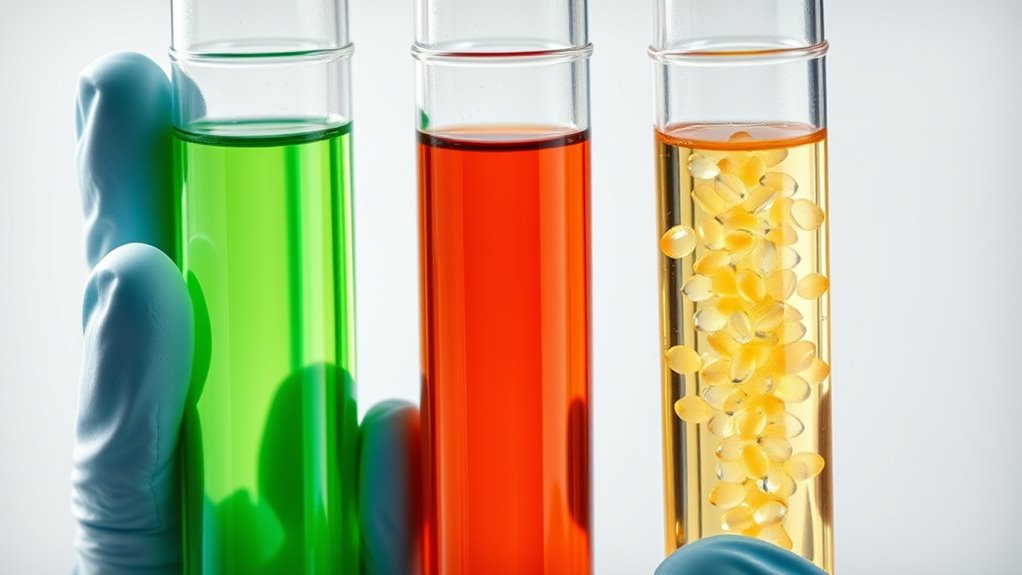
When selecting a sanitizer, safety should be your top priority. You want to guarantee that the method you choose effectively kills harmful bacteria and viruses without introducing risks to your health or the environment. UV sterilization is a popular option because it uses ultraviolet light to destroy microorganisms without chemicals. This method is fast, chemical-free, and leaves no residue, making it ideal for those concerned about chemical exposure. UV sterilizers are especially effective in small spaces like aquariums or water bottles, offering an instant disinfection process. Additionally, mineral purifiers, which often incorporate natural minerals, work alongside UV sterilization to improve water quality. These mineral purifiers release beneficial minerals that can help neutralize contaminants and improve water clarity, providing an extra layer of safety. Combining UV sterilization with mineral purifiers results in a safe, chemical-free approach that minimizes health risks while maintaining clean water.
While UV sterilization and mineral purifiers are effective, it’s also important to contemplate traditional chemical options like chlorine and bromine. Chlorine is widely used because it’s inexpensive and highly effective at killing bacteria and viruses quickly. However, it can form harmful byproducts when it reacts with organic matter, which may pose health risks over time. Bromine, on the other hand, is often preferred in hot water systems like spas because it remains stable at higher temperatures and is less irritating to the skin. Still, bromine can also produce disinfection byproducts and may cause allergic reactions in sensitive individuals. When choosing between these, consider the specific environment and your health concerns. Enzyme treatments are a different approach altogether, using naturally occurring enzymes to break down organic matter. They are gentle, eco-friendly, and pose minimal health risks, but they might require more frequent application to maintain water safety.
Ultimately, your choice depends on balancing effectiveness, safety, and environmental impact. UV sterilization paired with mineral purifiers provides a chemical-free, safe option suitable for most applications. Chemical treatments like chlorine and bromine are reliable but require careful handling and monitoring. Enzyme treatments offer a natural alternative but may not provide immediate disinfection. It is also worth noting that some glycolic acid products are formulated to improve skin texture and clarity, illustrating how chemical agents can serve specific purposes when used appropriately. When you prioritize safety, weigh factors like potential byproducts, ease of use, and long-term health effects. Always follow manufacturer instructions and consider your specific needs—whether it’s for drinking water, pool sanitation, or other uses—to select a sanitizer that keeps your environment safe and clean without compromising your health.
Frequently Asked Questions
Are There Natural Alternatives to Chemical Sanitizers?
Yes, you can use natural alternatives and organic sanitizers for your needs. Options like vinegar, hydrogen peroxide, and essential oils like tea tree or eucalyptus work as effective organic sanitizers without harsh chemicals. These natural alternatives help keep surfaces clean while reducing chemical exposure. Just make certain you follow proper application methods and concentrations to maintain safety and effectiveness. Switching to organic sanitizers can be a healthier choice for your home or environment.
How Do Sanitizers Affect Pool Equipment Longevity?
Sanitizers can be like silent predators, slowly wearing down your pool equipment. If you use chlorine or bromine, you increase corrosion risks, leading to costly repairs and frequent equipment maintenance. Enzyme treatments are gentler, helping extend equipment life. By choosing the right sanitizer, you safeguard your investment and keep your pool running smoothly. Regular maintenance and monitoring ensure your equipment stays in top shape longer, saving you time and money.
Can Mixing Different Sanitizers Improve Safety?
Mixing different sanitizers can sometimes improve safety, but it’s risky due to unpredictable chemical reactions. You should always maintain dosage consistency to prevent dangerous interactions that could cause skin irritation or reduce effectiveness. Before combining any sanitizers, consult manufacturer guidelines or a pool professional. Properly managing chemical levels guarantees safe, effective sanitation without compromising your pool equipment or health. Never mix chemicals without expert advice to avoid hazardous reactions.
What Are the Long-Term Health Impacts of Each Sanitizer?
You might think these sanitizers pose minimal long-term health risks, but chronic exposure can lead to issues like respiratory problems, skin irritation, or even increased cancer risk. Chlorine can cause asthma or eye irritation, bromine may affect your thyroid, and enzymes are generally safer but could cause allergic reactions over time. Always use sanitizers as directed and consider ventilation to reduce potential health impacts from long-term exposure.
How Do Seasonal Changes Influence Sanitizer Effectiveness?
Seasonal temperature fluctuations and sunlight exposure effects greatly influence your sanitizer’s effectiveness. As temperatures rise, chlorine may dissipate faster, requiring more frequent adjustments, while bromine remains stable in warmer water. Sunlight depletes chlorine quickly, so you’ll need to add more regularly. Enzyme treatments can be less affected by seasonal changes, but consistent monitoring guarantees ideal sanitation year-round. Adjust your maintenance routines based on seasonal conditions to keep your water safe and clean.
Conclusion
Ultimately, selecting a sanitizer is like tending a delicate balance—you want to preserve the sparkle without risking too much. Chlorine, bromine, and enzyme treatments each carry their own subtle whispers of caution and comfort. By thoughtfully considering their gentle nuances, you can nurture a safe, inviting environment. Trust your instincts, and remember, sometimes the quietest solutions offer the most harmonious peace of mind—allowing your space to shine softly and securely.
